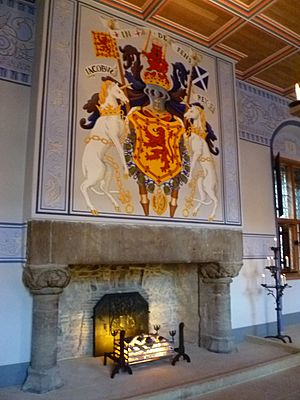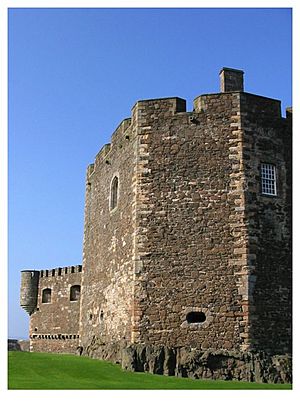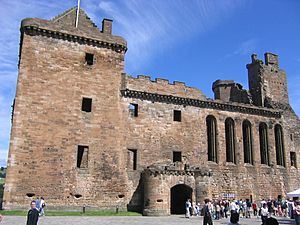James Hamilton of Finnart facts for kids
Sir James Hamilton of Finnart (born around 1495 – died August 16, 1540) was an important Scottish nobleman and a skilled architect. He was the son of James Hamilton, 1st Earl of Arran, and Marion Boyd. Even though he was made a legitimate heir in 1512, he was often called the "Bastard of Arran." As a key member of the powerful Clan Hamilton and a cousin of King James V, he became a very influential person in Scotland.
Contents
Rising to Power
James Hamilton was given the lands of Finnart in 1507 and became a knight in 1511 when he was still young. As a child, he joined the King's household. In 1513, he was named his father's heir, in case his father had no other legitimate children.
In 1520, Hamilton was involved in a famous street fight in Edinburgh called "Clear the Causeway" with the Earl of Angus. Hamilton and his father managed to escape by taking horses and crossing the Nor Loch marshes. In September 1526, after a battle, Hamilton was involved in the death of John Stewart, 3rd Earl of Lennox. Soon after, on October 22, 1526, Hamilton was made the Keeper and Captain of Linlithgow Palace.
The historian George Buchanan wrote that a groom tried to stab Hamilton in revenge for Lennox's death, but Hamilton was unharmed. At court, he became a "principal sewer," which meant he was a noble waiter at the King's table, and also the master of the King's stables. He was involved in some religious conflicts of the time. When his father died in 1529, he became the guardian of his younger half-brother, James, 2nd Earl of Arran. For a while, he was the most powerful person in the Hamilton family and one of the most influential men in Scotland.
In November 1528, an English diplomat named Thomas Magnus described Sir James Hamilton as one of the young King's important advisors. Magnus also heard that Hamilton met with some rebels to discuss bringing back the Earldom of Angus. This meeting would later be used against Hamilton.
Royal Architect: Building Palaces and Castles

Sir James Hamilton was appointed the Steward of the Royal Household and the Master of Works for King James V. This meant he was in charge of royal building projects. King James gave Hamilton the Draffan estate in Lanarkshire, where he built Craignethan Castle in 1530. He also likely built Cadzow Castle near the town now called Hamilton.
In 1536, Hamilton helped King James V get equipment for hunting, including horses, hounds, and hawks. As Master of Works, he was responsible for fixing up royal palaces like Linlithgow Palace, Blackness Castle, and possibly Falkland Palace. His biggest project was creating the beautiful Renaissance palace at Stirling Castle, for which he received many rewards.

In 1537, Hamilton was given money for his work at Linlithgow and Blackness Castle. This way of paying him continued. On September 22, 1539, at Stirling Castle, Finnart received a large gift of lands. This was to thank him for finishing the work at Stirling Palace and Linlithgow Palace. These lands included Strathaven Castle and others, which became a new area called the Barony of Avondale. Finnart's building work continued at Stirling Palace with a payment of £4000 Scots in October 1539, and £300 for work at Linlithgow and Blackness Castle in April 1540.

After his death in August 1540, Finnart still owed money for the building work at Stirling Palace. The royal blacksmith, William Hill, was paid for the ironwork he had made. A priest, Sir James Nycholsoun, finished the work at Stirling that Finnart had started in May 1538.
His Downfall
In 1540, King James V became convinced that Hamilton was plotting against him. Hamilton was arrested in late July. On August 16, he was put on trial, found guilty, and executed. The charges against him were old, some dating back 12 years.
After Finnart was executed in Edinburgh, King James V took over Craignethan Castle. The silver items from the castle's chapel were taken to Edinburgh and engraved with the King's infant son's coat of arms.
A chest containing Finnart's papers was brought to Edinburgh, and many of them were destroyed by royal officers. Cardinal Beaton gave money to Finnart's widow because she was his relative.
After his death, it is said that Finnart appeared to King James V in a dream. He supposedly told the King that he "would shortly lose both arms, then his head." This prophecy seemed to come true, as the King lost both of his young sons in 1541 and then died himself in 1542. This story was written down by historians John Knox and George Buchanan.
Why He Was Executed
The execution of James Hamilton of Finnart is a topic of historical interest. Some historians have suggested it showed how cruel and greedy King James V could be. Other historians, like George Buchanan, believed Finnart was a close friend of Cardinal Beaton and supported the Catholic Church. These historians thought Finnart's enemies were Protestants in Scotland.
Another idea is that Finnart tried to stop King James V from meeting Henry VIII of England and marrying Princess Mary. He also might have tried to mess up the King's French marriage plans by leading his ships off course in August 1536.
An old account from 1570, written after a Hamilton family member assassinated Regent Moray, gives another view. This account says that the charges against Finnart were very old. It also claimed that Finnart tried to delay the King's marriage so that the Hamilton family might become kings of Scotland if James V died without heirs. According to this account, Finnart then fell out of favor with the King.
The exact reasons for Finnart's execution are still not completely clear. Some modern historians, like Jamie Cameron, doubt that his role was as important as some of these older accounts suggest.
His Family
Finnart married Margaret Livingston of Easter Wemyss before 1529. They had several children:
- James Hamilton of Crawfordjohn
- Agnes Hamilton, who married James Somerville, 6th Lord Somerville
- Grissel Hamilton, who married Andrew Leslie, 5th Earl of Rothes in 1548
- Elizabeth Hamilton, who married John Maxwell of Calderwood
A family history says that King James V attended Agnes's wedding at Craignethan, perhaps on April 8, 1536. However, some modern historians are not sure if this is true.
James also had at least ten children outside of marriage with different women.
Images for kids
-
The hall Hamilton of Finnart built for himself at Craignethan Castle
-
At Linlithgow Palace, Hamilton of Finnart reconstructed the entrance façade
| Preceded by Sir James Nicolson |
Master of Work to the Crown of Scotland 1538–1540 |
Succeeded by John Hamilton of Milnburne & John Scrimgeour of Myres |



